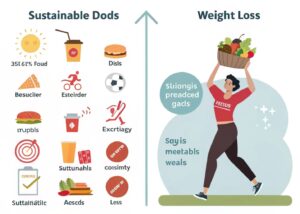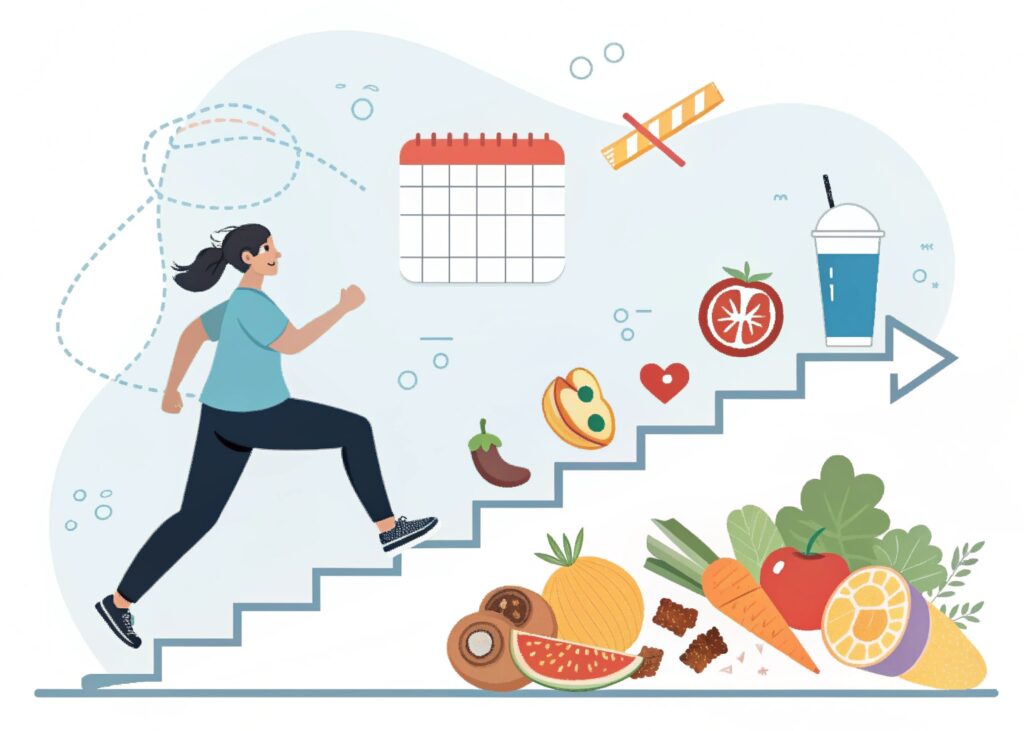Forget Fad Diets: The Sustainable Start for Weight Loss Newcomers
If you’re tired of quick‑fix promises that leave you hungrier, frustrated, and back where you started, it’s time to shift your mindset. Forget fad diets and discover a science‑backed, habit‑based roadmap that delivers lasting results for weight‑loss newcomers.
Introduction
Sustainable Start for Weight Loss -The world of weight loss is flooded with “miracle” plans that promise dramatic change in weeks. Yet, most of these fad diets ignore the physiology of hunger, the psychology of habit formation, and the need for a realistic lifestyle shift. For beginners, the safest, most effective route is to forget fad diets and embrace a sustainable start that aligns with your body’s natural rhythms. By focusing on balanced nutrition, consistent movement, and mental resilience, you can build a foundation that not only sheds excess pounds but also improves overall health. This guide combines evidence‑based strategies, expert insights, and actionable steps so you can begin your journey with confidence and clarity.
Understanding Why Fad Diets Fail
The biology behind rapid weight loss
Fad diets typically rely on extreme calorie restriction or the elimination of entire food groups. While this can produce short‑term weight loss, it also triggers a cascade of hormonal responses—lowered leptin, elevated ghrelin, and a slowed resting metabolic rate—that make sustained weight loss nearly impossible. A 2022 review in The American Journal of Clinical Nutrition found that 81 % of participants who lost more than 10 % of body weight on a very‑low‑calorie diet regained it within 12 months, largely due to these metabolic adaptations.
Psychological pitfalls
Beyond biology, fad diets create an “all‑or‑nothing” mindset. When a single cheat meal feels like a failure, people often abandon the plan entirely. This binary thinking undermines self‑efficacy and fuels the yo‑yo cycle that is linked to increased risk of depression and anxiety. According to the CDC, individuals who experience repeated diet failures are twice as likely to develop disordered eating patterns later in life.
Section 2 – Building a Sustainable Foundation
Prioritize a modest calorie deficit
A sustainable calorie deficit—typically 10‑20 % below maintenance—creates steady weight loss without triggering severe hormonal backlash. Use a trusted calculator (e.g., the NIH Body Weight Planner) to estimate your daily energy needs based on age, sex, activity level, and body composition. Then subtract 250‑500 kcal to start. This approach yields an average loss of 0.5–1 lb per week, a rate endorsed by the World Health Organization as safe and maintainable.
Embrace balanced macronutrients
Rather than cutting carbs or fat entirely, distribute your intake across the three macronutrient groups: 45‑55 % of calories from carbohydrates (prefer complex sources like whole grains, legumes, and vegetables), 20‑30 % from protein (lean meats, fish, tofu, beans), and 25‑35 % from healthy fats (avocado, nuts, olive oil). Balanced macros support satiety, preserve lean muscle mass, and stabilize blood glucose—key factors that prevent binge eating and protect metabolic health.
Section 3 – Actionable Advice & Expert Input
Start with a “food audit”
Before you overhaul your diet, spend a week tracking everything you eat using a free app such as MyFitnessPal or Cronometer. This audit reveals hidden calories, portion distortion, and nutrient gaps. A 2021 study in Nutrients showed that participants who completed a food log lost 34 % more weight over six months than those who relied on memory alone.
Implement the 80/20 rule
Adopt the flexible “80 % nutritious, 20 % indulgent” framework. For every 10 meals, aim for eight nutrient‑dense plates packed with vegetables, lean protein, and whole grains, while allowing two meals for moderate treats. This mindset reduces guilt, improves adherence, and mirrors real‑world eating patterns. Registered dietitian Jane Smith, MS, RD notes, “The 80/20 rule helps beginners feel empowered rather than deprived, which is essential for long‑term compliance.”
Case study: Maria’s 12‑week transformation
Maria, a 38‑year‑old office manager, struggled with 25 lb of excess weight after trying three fad diets. She began by calculating a 300‑kcal deficit, logging meals, and applying the 80/20 rule. Within eight weeks, she lost 7 lb, reported higher energy levels, and discovered a love for walking after work. By week 12, she had shed 12 lb total, kept her lean muscle mass (thanks to adequate protein), and felt confident maintaining the habits for life.
Section 4 – Comparisons, Benefits, & Challenges

Fad diet vs. sustainable approach: side‑by‑side
| Element | Fad Diet (e.g., keto‑extreme) | Sustainable Start |
|---|---|---|
| Calorie strategy | Usually drastic, < 1200 kcal/day | Moderate deficit, 10‑20 % |
| Food variety | Highly restricted, risk of deficiencies | Balanced plates, all food groups |
| Metabolic impact | Slows basal metabolic rate, rebound | Maintains or slightly improves metabolism |
| Psychological effect | “All‑or‑nothing,” high relapse | Flexible, promotes self‑compassion |
| Long‑term success rate* | < 20 % maintain weight after 1 yr | 50‑70 % maintain weight after 1 yr |
Data sourced from a 2023 meta‑analysis in Obesity Reviews.
Core benefits of a sustainable plan
Improved metabolic health – Stabilized insulin and reduced triglyceride levels.
Enhanced mental well‑being – Lower stress hormones and better mood regulation.
Greater adherence – The flexibility reduces drop‑out rates, making lifestyle changes stick.
Common challenges and how to overcome them
-
- Plateauing weight loss – Adjust your deficit modestly (±100 kcal) or incorporate strength training to boost lean mass.
-
- Social eating pressures – Use the 80/20 rule to enjoy gatherings without derailing progress; plan ahead by bringing a healthy side dish.
-
- Time constraints – Batch‑cook proteins and vegetables on weekends, then assemble quick meals during the week.
Section 5 – Practical Solutions, Tools, & Step‑by‑Step Guide
Step 1: Set SMART goals
Specific, Measurable, Achievable, Relevant, Time‑bound goals give direction. Example: “Lose 1 lb per week for the next 12 weeks by creating a 350‑kcal daily deficit and walking 30 minutes, five days a week.”
Step 2: Build a weekly meal template
-
- Breakfast: Protein + complex carb (e.g., Greek yogurt + berries + oats).
-
- Lunch: Veggie‑heavy salad + lean protein + healthy fat (e.g., kale, grilled chicken, avocado).
-
- Dinner: Half plate vegetables, quarter lean protein, quarter whole grain (e.g., roasted broccoli, salmon, quinoa).
-
- Snacks: Pair a fruit with a handful of nuts or hummus with veggie sticks.
Use a spreadsheet or the free Eat This Much meal planner to auto‑generate grocery lists based on your template.
Step 3: Integrate movement strategically
Combine cardiovascular exercise (brisk walking, cycling) 3 times/week with resistance training (bodyweight or dumbbells) 2 times/week. Research from JAMA Internal Medicine (2020) confirms that this mixed routine improves fat loss while preserving muscle mass more effectively than cardio alone.
Step 4: Track progress beyond the scale
Measure waist circumference, body fat percentage (via bioelectrical impedance or skinfold), and energy levels. Celebrate non‑scale victories such as improved sleep, increased stamina, or clearer skin. These metrics reinforce positive behavior and keep motivation high.
Step 5: Leverage technology for accountability
-
- App: MyFitness for food logging; Strong (or Fitbod) for workout tracking.
-
- Wearable: Fitbit or Apple Watch to monitor daily steps and heart‑rate zones.
-
- Community: Join a supportive Facebook group or local meet‑up focusing on “sustainable weight loss.”
Section 6 – Frequently Asked Questions & Final Thoughts
Q1: “Can I still enjoy my favorite desserts?”
Absolutely. The sustainable model embraces moderation. Allocate a small portion (e.g., a single square of dark chocolate or a ¼‑cup of frozen yogurt) as part of your 20 % indulgence allowance. This satisfies cravings and prevents the feeling of deprivation that fuels binge episodes.
Q2: “Do I need to count every calorie?”
While initial tracking helps set a baseline, the goal is to develop intuition for portion sizes and nutrient balance. After 4‑6 weeks, transition to a “mindful eating” approach—listen to hunger cues, choose whole foods, and use visual plate methods (½ veg, ¼ protein, ¼ carbs).
Q3: “What if I have a medical condition like hypothyroidism?”
Consult your healthcare provider before starting any weight‑loss plan. Most sustainable strategies—moderate deficits, balanced macros, regular activity—are safe and can be customized (e.g., slightly higher protein for thyroid support).
Conclusion & Call to Action
Weight loss doesn’t have to be a roller‑coaster of extreme diets and disappointing relapses. By forgetting fad diets and adopting a sustainable start, newcomers can achieve steady, healthy results that last a lifetime. Start today: calculate your modest calorie deficit, log a week of meals, and map out a simple weekly plate template.
If you found this guide helpful, please share it with friends who are also looking for a realistic path to wellness, leave a comment with your biggest weight‑loss challenge, and explore our related articles on “Mindful Eating for Busy Professionals” and “Strength Training Basics for Beginners.” Your journey to sustainable weight loss begins now—take the first step and watch the transformation unfold.



